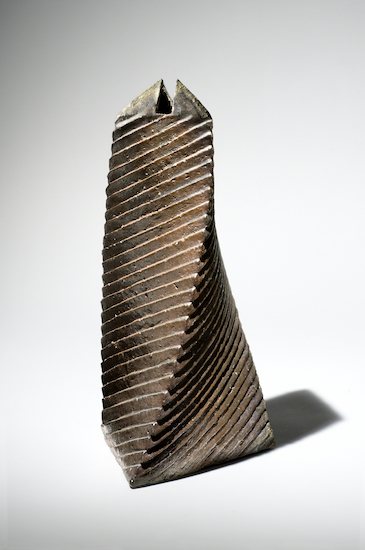Artist Birthday: Matsuzaki Kenichi
Kenichi Matsuzaki exemplifies the richness of the contemporary ceramic art of Japan. His rough surface stoneware works pay tribute to the centuries old traditions of Japanese ceramics, one of the oldest traditions of decorated pottery in the world.
Artist Birthday for 15 October: Matsuzaki Kenichi (born 1950 Japan)
 |
|
Matsuzaki Kenichi, Vase, ca. 2003, stoneware with ash glaze, 36.8 x 20.3 x 15.2 cm Philadelphia Museum of Art, © 2025 Kenichi Matsuzaki (PMA-4743) |
True to the mingei (“art of the people”, or, folk art) tradition of ceramics, no two Matsuzaki stoneware vessels are the same. The artist celebrates mishaps in firing or making of a piece. The daring shape of this vessel, with its incised decoration emphasizing the twist of the form, reveals at the bottom the uneven, often haphazard effects of an ash glaze. Ash glazes have in Japan traditional made from burnt rice husks, but many potters like Matsuzaki use wood ash. The ash is produced in the kiln during firing and settles on the vessel forming a matte glaze. However, some ash glazes are high in silica and can have a glossy surface when applied mixed with a slip.
Background
Artists of the Jomon Period in Japan (ca. 3000-200 BCE), produced some of the oldest extent utilitarian ceramic forms that had decoration for aesthetic rather than functional reasons. Ceramic arts have traditionally been considered "fine art" in Japan, much in contrast to the western perception of "decorative arts." The flowering of the tea ceremony in Japan during the Muromachi Period (1392-1573) with its important component of flower arranging cemented the honored place ceramics has long held in Japanese art.
In the early 1900s, inspired by the British Arts and Crafts Movement, reacting against the rapid "westernization" and industrialization of Japan, a group of ceramic artists founded the Japanese Folk Art Association, which fostered the idea of the studio ceramic artist, one who actively participates in every aspect of ceramic making. The return to traditional decorative arts is called the mingei movement.
The need to restore national identity after the disaster of World War II (1939-1945) helped strengthen the movement to fortify traditional art forms. At the same time, many younger Japanese artists, rejecting the strictures of traditional Japanese art forms, sought inspiration from Western art as Japan rapidly became part of the modern world.
Western inspired artists emerged in Japan during the same period in America, the late 1940s and 1950s, when the perception of ceramics transcended from merely utilitarian arts to fine art. An example of this would be the work of the American artist Peter Voulkos (1924-2002). Like Voulkos , the pioneering modern ceramic artists of Japan use traditional Japanese ceramic forms, and the traditional respect for the medium, as a jumping off point to introduce uniquely modern ceramic art.
Kenichi Matsuzaki was born in Tokyo. He developed an interest in ceramics around age 16. He received a degree in ceramics from Tamagawa University School of Fine Arts, Tokyo, in 1972. He then did a 5 -year apprenticeship with then National Living Treasure Tatsuzo Shimaoka (1919-2007).
During his time with Shimaoka, Matsuzaki developed his own unique style, creating his own motifs and a palette of glazes he uses to this day. Matsuzaki's aim with his ceramics is to create works that "make people happy." He is closely associated with the mingei movement, with works that often symbolize historical mingei glazes like yohen, shino, and Oribe wares.

Comments